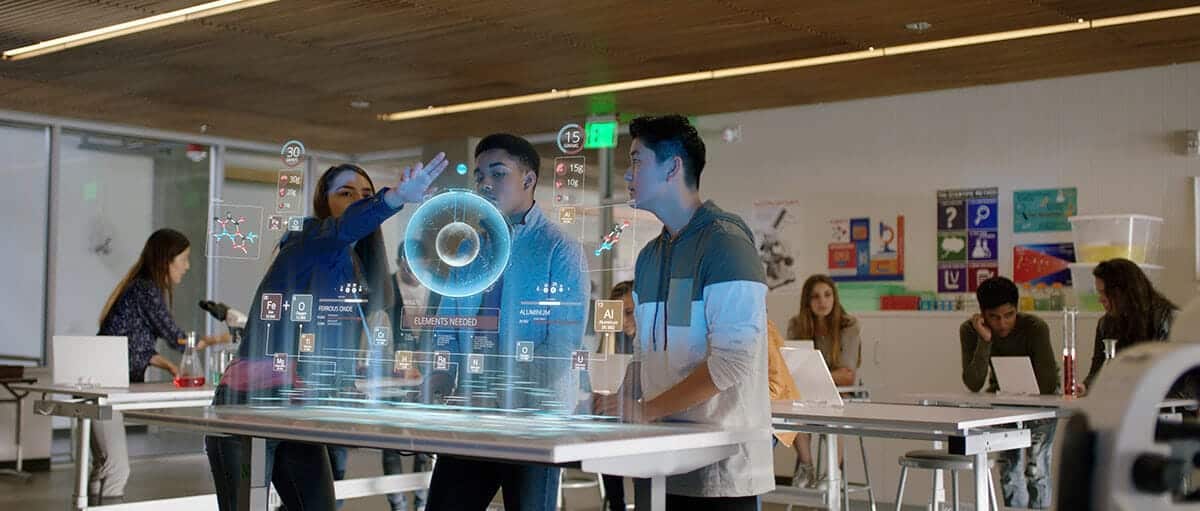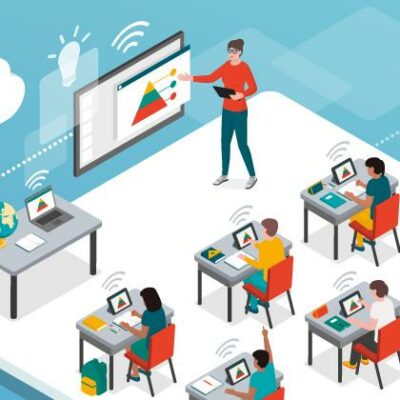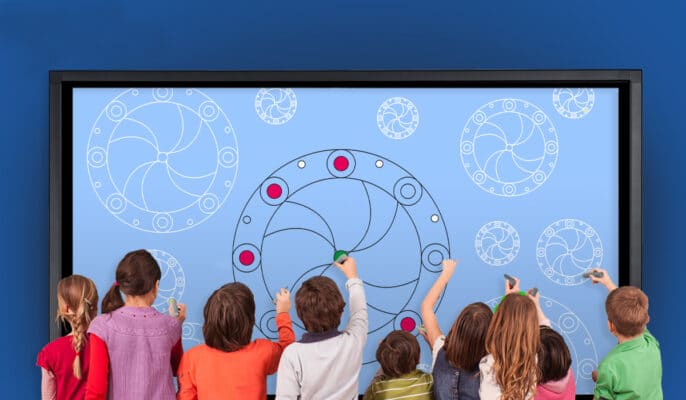“Augmented classrooms”: from the interactive whiteboard to today’s and future perspectives, possible technologies contemplated in the School 4.0 Plan and the NRP, and potential to be explored.
We discover the possible evolutions of the classrooms of a future that is already here, especially if attention is paid to technologies, practices, and strategies for obtaining funds and spending them in a targeted and effective manner.
Sommario
- 1 Interactive whiteboards and augmented reality: a linear evolution
- 2 NRP and schools, how to spend the funds?
- 3 Laboratory teaching and the School Plan 4.0
- 4 Classrooms of the future: labs and the eduverse
- 5 What is it and how did the interactive whiteboard come into being?
- 6 What to do with the interactive whiteboard? 5 hands-on activities
- 6.1 1. Elementary school: Patterns of verb tenses
- 6.2 2. Geometry: Graphical representation and calculation of formulas.
- 6.3 3. Eighth grade: Creating concept maps.
- 6.4 4. Foreign languages and high school: Clear and engaging grammar
- 6.5 5. Inclusion and diversity: Support for disabled and foreign pupils
- 7 From the interactive whiteboard to current technologies
- 8 Current and future perspectives
- 9 Possible technologies and potential to be explored
- 10 Case Studies, Research and Examples
- 11 Beyond the interactive whiteboard: toward an Educational Augmented Reality.
- 12 Potential of Augmented Reality in Education
- 13 Practical implementation: The use of Augmented Reality in classrooms
- 14 A new educational paradigm
- 15 REQUEST A NO-OBLIGATION DEMO
- 16 About Fastbrain and why to choose it
Interactive whiteboards and augmented reality: a linear evolution
“Six out of 10 students are bored in the classroom*. Half of students believe that school cannot help them develop their creativity, and nearly one in two students dream of a school with large spaces and labs in which to study.” *
*Flipnet National Conference “This school is not for me. Innovative proposals for creativity, inclusion, well-being and freedom” Roma3 University.
That’s where the “classrooms of the future” come in, although by now the future already has a name and a concrete location: augmented reality (AR) technologies, which, coupled with the most effective teaching techniques, can make the difference between a bored and quit pupil and an engaged and proactive one.
If interactive whiteboards have laid the foundation for more interactive learning, Augmented Reality presents itself as the new technological paradigm, already in use in various training and educational settings.
The transition from interactive whiteboards to AR represents a significant change in the way students acquire knowledge.
The ultimate goal is to create classrooms of the future in which technology is not just a tool, but a facilitator of engaging, personalized and future-oriented learning.
NRP and schools, how to spend the funds?
“The school has 2.1 billion to spend on technology. But he doesn’t know how to do it “*. The title of an article in Wired magazine, highlights the stalemate between available funds and implementation difficulties.
We have already discussed this, in fact, in several articles devoted to the subject.
The bottom line is, as pointed out in Wired, that the plan can work “if there is a plan behind it, an idea of how to change teaching.
And, in the case of laboratories, which ones to renovate and how. Otherwise, you run the risk of moving to a shopping list of products to buy.”
How and where to communicate projects
Projects, should be reported on Future School, the platform dedicated to the NRP by the Ministry of Education.
Below is a link to guidance on how to submit a project, access reference sites, and submit accounting data.
Fastbrain is present on MEPA purchases as a supplier for all purchases related to the School 4.0 Plan and projects related to the NRP, in order to build laboratory classrooms and acquire the necessary technological equipment.
Laboratory teaching and the School Plan 4.0
Presidential Decree 88/2010 brought to the school’s attention laboratory teaching and that of problem solving, understood as The set of techniques and methodologies necessary for the analysis of a problem situation in order to identify and implement the best solution. (Source: Oxford Languages)
As per the School 4.0 Plan and specifically the “Next Generation Classrooms” action, the goal “to transform at least 100,000 classrooms in primary, secondary, and junior high schools into innovative learning environments.
Each educational institution has the opportunity to transform half of the current classrooms/classrooms thanks to NRP funding.” Next Generation Classrooms envisions that first- and second-cycle school communities can design and implement:
“Physical and digital learning environments (on-life), characterized by innovation in space, furniture and equipment and a core of innovative pedagogies for their most effective use, according to the principles outlined by the national and European framework. Physical and virtual transformation must be accompanied by change in learning and teaching methodologies and techniques.” (School Plan 4.0. p.18).
In this process of transformation, augmented reality can concretely support advanced digital training and skills experiences even outside of laboratories, simulating real work contexts and workplaces at school.
“In high schools, the digital professions laboratories of the future can be functional for the development of the most advanced digital skills in the disciplines characterizing the course of study, while in technical and professional institutes they can be oriented toward the enhancement of the specific digital skills of the economic sectors related to the professional exit profile.
The design team, under the coordination of the school leader, identifies the technological areas on which to design, according to a multidimensional perspective, the laboratories, including using existing spaces, but re-functionalizing them based on the new furniture and equipment and the new digital skills required.” (p.34)
Classrooms of the future: labs and the eduverse
The aforementioned School Plan 4.0, stipulates that alongside the design of physical labs, virtual labs should also be associated, making use of tools such as augmented reality and all related technologies.
This would make it possible to simulate work contexts, for example, by acquiring software and platforms integrated with the use of the devices.
Ask our team for a demo and consultation on designing a technology-enabled and innovative classroom
In this regard, the document refers to eduverse:
“Physical learning environments today cannot be designed without also taking into account digital environments (online environments via e-learning cloud platforms and immersive virtual reality environments) to configure new dimensions of hybrid learning.
The use of the metaverse in education constitutes a recent field of exploration, theeduverse, which offers the possibility of obtaining new “spaces” of social communication, greater freedom to create and share, offering new immersive educational experiences through virtualization, creating an educational and scholastic continuum between physical space and virtual space for learning, i.e., an onlife learning environment.
Common safety, comfort, and privacy requirements must be ensured for both in-presence and digital learning environments, including the provision of specific educational actions about the risks associated with the misuse of technologies.” (School Plan 4.0 p.22)
What is it and how did the interactive whiteboard come into being?
The Interactive Multimedia Whiteboard (Interactive Whiteboard ) represents an electronic device connected to a personal computer, consisting of a large rectangular surface on which one can write with special pens or fingers, use the Internet, record sounds and images, and share the work done.
This tool has been introduced experimentally in schools and has attracted media attention.
The interactive whiteboard consists of an interactive surface, a projector and a computer, integrating keyboard, mouse and screen functions.
Equipped with touch screen technology, it enables writing, drawing, calculating and projecting, facilitating interaction with teaching materials.
Experts emphasize the educational advantages of the interactive whiteboard, emphasizing multimedia, the ability to capture students’ attention and stimulate their curiosity, as well as the interactivity that fosters emotional involvement and relationship with others.
The history of the interactive whiteboard
The 2000 European Strategy encouraged school computerization, calling for teachers to be able to use the Internet and multimedia resources by 2002.
In response to this, the DIGI School in Italy project was launched in 2006, aimed at introducing digital content into educational work.
The interactive whiteboard has played a key role in this context, parallel to the spread of Interactive White Boards in Britain.
However, despite efforts to integrate the interactive whiteboard into the Italian school environment through projects such as DIGI School and Digital School, the survey conducted in the 2012-2013 school year revealed that interactive whiteboard integration was still in the experimental stage.
Teachers complain of insufficient preparation in using the tool, despite general satisfaction and autonomy in using basic functions.
Finally, while the interactive whiteboard continues to be used in schools, new technologies, such as tablets and iPads, are expected to arrive that could surpass the interactive whiteboard itself.
These innovative devices challenge the traditional approach to the lesson and the teacher-student relationship, suggesting a possible evolution in education.
Ask for a free consultation on the use of technology in your school
What to do with the interactive whiteboard? 5 hands-on activities
Here are five hands-on activities that have proven to be effective with the interactive whiteboard in recent years:
1. Elementary school: Patterns of verb tenses
– Use of interactive whiteboard to summarize verb tenses and irregularities in Italian grammar;
– Highlighting of suffixes with different colors and formats to aid memorization;
– Engaging students with interactive exercises and playful games.
2. Geometry: Graphical representation and calculation of formulas.
– Make use of the interactive whiteboard to represent geometric figures and calculate mathematical formulas;
– Active involvement of the class in problem solving;
– Use of previously saved exercises to ensure appropriate understanding of the topic.
3. Eighth grade: Creating concept maps.
– Use of the interactive whiteboard to create concept maps for final exams;
– Use of arrows, brackets and colors to schematize the entire program;
– Highlighting dates, agreements and crucial moments for deeper understanding.
4. Foreign languages and high school: Clear and engaging grammar
– Innovative approach to foreign languages, using interactive whiteboard to explain grammar clearly;
– Videos, interviews and interactive exercises to boost vocabulary and language fluency;
– Use of exercises such as fill in the black, drag and drop, matching and ordering to consolidate skills.
5. Inclusion and diversity: Support for disabled and foreign pupils
– Adapting the interactive whiteboard for inclusive programs, with differentiated margins and specific fonts to facilitate reading.
– Revolution in teaching, enabling lessons suitable for all students, regardless of differences.
– Use of technology to promote inclusion, participation and better understanding.
The interactive whiteboard proves to be a versatile and easily accessible tool, suitable for school projects and remedial activities, thus contributing to the digitization of the Italian educational environment.
From the interactive whiteboard to current technologies
Interactive Multimedia Whiteboards (IWBs) have been a key step towardintegrating technology into classrooms.
However, educational technology has advanced greatly, leading to an evolution of traditional classrooms into true multimedia classrooms.
Today, the use of devices such as tablets, laptops and interactive projectors has become commonplace, expanding the possibilities for student learning and engagement.
Current and future perspectives
Current prospects for multimedia classrooms highlight the importance of high-speed Internet access and digital platforms.
Students can access online resources, participate in virtual classes and collaborate on real-time projects.
In addition, emerging technologies such as virtual reality (VR) and augmented reality (AR) promise to take the learning experience to new levels, enabling students to immerse themselves in interactive and immersive educational settings.
Possible technologies and potential to be explored
There are many possible technologies for the classrooms of the future.
Integration of artificial intelligence (AI) could personalize learning according to students’ individual needs, providing tailored learning paths.
Data analytics systems could help teachers assess student performance in real time and adjust teaching strategies accordingly.
The potential to be explored also extends to the use of wearable devices and IoT (Internet of Things) technologies to create interconnected and interactive classrooms.
Students could wear devices that monitor their attention level or provide instant feedback on learning.
These innovations could make learning more adaptive and engaging.
Case Studies, Research and Examples
Numerous case studies demonstrate the tangible benefits of multimedia classrooms.
In institutions that adopted the use of tablets for each student, improved interaction and active participation were observed.
Research on the effectiveness of “augmented” classes * highlight the potential to reach students in remote areas or areas with limited educational resources.
One successful example is Khan Academy, an online platform that offers interactive video lessons on a wide range of topics. This type of resource demonstrates how technology can democratize access to quality education.
Beyond the interactive whiteboard: toward an Educational Augmented Reality.
The transition to the classrooms of the future does not stop at the interactive whiteboard.
Augmented Reality (AR) is emerging as the next frontier, enabling an even more advanced level of interactivity and engagement.
While the interactive whiteboard provides a two-dimensional experience, AR adds a three-dimensional element, overlaying digital information on top of the real world.
Potential of Augmented Reality in Education
- Immersive Experiences: Augmented Reality allows students to immerse themselves in virtual contexts and interact with three-dimensional objects.
For example, students can explore the solar system or study the structure of cells in a more engaging way.
- Collaboration-based learning: AR tools enable real-time collaboration.
Students can work together on virtual projects, even if they are physically distant, thus enriching the learning experience.
- Adaptation to different abilities: Augmented Reality offers customization options for students with different learning abilities.
Through three-dimensional visualization, teaching materials can be adapted to meet the specific needs of students.
Practical implementation: The use of Augmented Reality in classrooms
Practical application of Augmented Reality in future classrooms could include:
– Virtual Tours: Students can take virtual tours of historical places or explore the human body through AR devices.
– Interactive Simulations: Three-dimensional simulations enable students to understand complex scientific concepts in a hands-on way.
– Augmented Learning Books: Integrate textbooks with AR content to make reading more interactive and engaging.
A new educational paradigm
The transition from interactive whiteboards to AR represents a significant change in the way students acquire knowledge.
The ultimate goal is to create classrooms where technology is not just a tool, but a facilitator of engaging, personalized and future-oriented learning.
Exploring these potentials is crucial to shaping an increasingly inclusive educational “tomorrow” that is adaptable to the needs of modern society.
About Fastbrain and why to choose it
Fastbrain Engineering Ltd. Certified Partnerof leading Technology Players, including RealWear®, Brother, Lenovo, Synology, Graetz, SiComputer, Canyonoffers customized purchasing solutions tailored to the needs of professionals. It also offers pre- and post-sales support,including operational rental. We are acentralplayer in ICT wholesale distribution and one of the leading players throughout the country in the IT and technology products distribution market. A key feature and competitive advantage is the selection of top brands and leading products in the most popular product categories.
Info:
info@fastbrain.it
| Tel 011.0376.054
Resources and sources:
*https://www.wired.it/article/scuola-pnrr-classi-laboratori-realta-virtuale-bandi/
History and definition of LIM:https://www.treccani.it/90anni/parole/2007-lim.html
https://www.scuola.net/news/494/5-attivita-pratiche-che-puoi-fare-con-la-lim
https://pnrr.istruzione.it/wp-content/uploads/2022/07/PIANO_SCUOLA_4.0_VERSIONE_GRAFICA.pdf
* The impact of augmented reality on student attitudes, motivation, and learning achievements-a meta-analysis (2016-2023) https://www.nature.com/articles/s41599-023-01852-2
https://www.sciencedirect.com/science/article/pii/S036013151930051X#sec8
https://www.ilsole24ore.com/art/sei-studenti-10-si-annoiano-classe-ACDFhMv
https://pnrr.istruzione.it/wp-content/uploads/2023/01/Guida_FUTURA_Gestione-progetti_Come-presentare-un-progetto-Costi-reali_v1.2.pdf
https://scuolafutura.pubblica.istruzione.it/
https://www.scuola.net/news/494/5-attivita-pratiche-che-puoi-fare-con-la-lim




